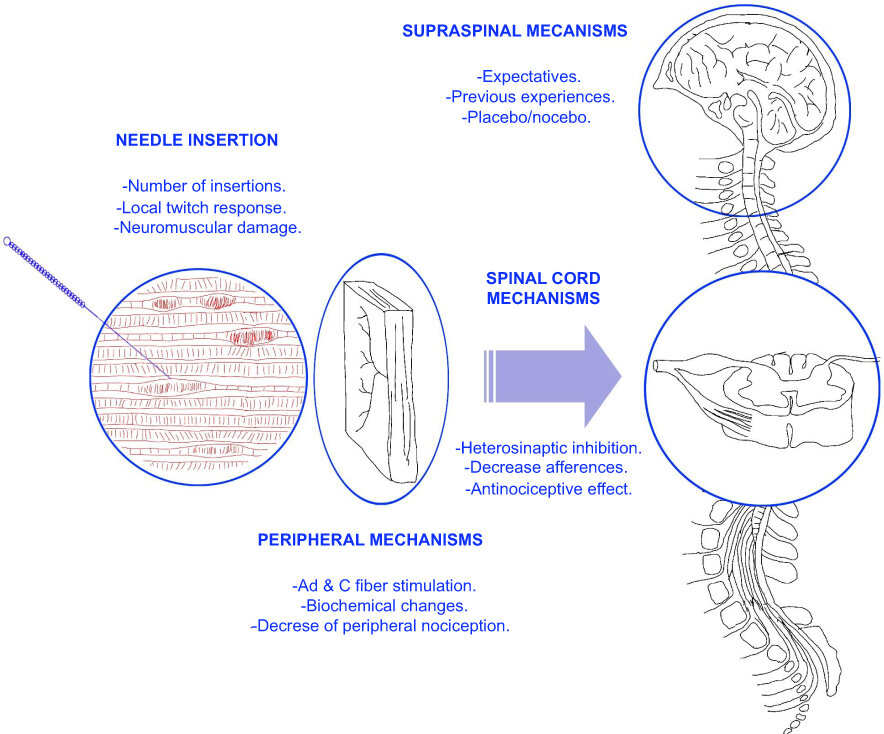Dry Needling (Western Acupuncture)
What is Dry needling & Western Acupuncture
The terms ‘acupuncture’ and ‘dry needling’ are often used interchangeably in sports medicine to describe treatments using thin monofilament needles without injection of any medication.
However, acupuncture denotes the use of the modality within a traditional Chinese medical paradigm, in which needles are used to unblock the flow of vital energy, ‘qi’, along meridians or channels, whereas dry needling implies the use of a Western biomedical paradigm. ‘Wet needling’ is a less common technique used involving the injection of chemicals into trigger points or areas of muscle tension to achieve similar outcomes.
Some dry needling schools will draw from Eastern philosophies and traditional Asian (and even some Ayurvedic) techniques and integrate them into a Western model of medicine. This is becoming more common as more is discovered about the effectiveness and scientific basis behind why and how some people respond to certain alternative therapies as they do.
How Does Dry Needling Work?
Fernández-de-Las-Peñas C, Nijs J (2019)Trigger point dry needling for the treatment of myofascial pain syndrome: current perspectives within a pain neuroscience paradigm. DOI: https://doi.org/10.2147/JPR.S154728 Dry needling is thought to have a range of neural and biochemical effects that can contribute to pain relief. Insertion of needles stimulates free nerve endings, sensory receptors and autonomic fibres in skin, muscle and connective tissue. It also causes the release of a range of neuroactive mediators, including endogenous opioids, which can inhibit transmission of nociceptive signals in the peripheral and central nervous system and alter pain perception. Causing low-level, isolated tissue injury with needle insertion can also cause positive inflammatory and immune responses, which can contribute to analgesia/pain relief.
Dry needling is most commonly used to treat intramuscular trigger points, but methods targeting joints, tendons, ligaments, bone and scar tissue can also be implemented by those trained in more advanced techniques. Trigger point techniques often aim to produce a local muscular twitch response, thought to be caused by stimulation of a spinal reflex loop.137
This has been linked to an immediate reduction in extracellular neurotransmitter concentration in muscle tissue surrounding a trigger point,138 and a twitch response is anecdotally thought to indicate the needle has ‘hit the right spot’. Research hasn’t shown consistent evidence that this is true and effective treatment outcomes can still be achieved without local twitch responses.
There is a vast amount of research on the effects of dry needling and acupuncture. However, interpretation of this research is sometimes complicated by the wide variety of conditions treated, differing underlying treatment paradigms (traditional Chinese medicine versus a Western biomedical model), as well as a large variation in treatment protocols and study quality.
Nevertheless, a substantial amount of high quality evidence suggests dry needling is more effective than placebo or sham treatments for a range of musculoskeletal conditions such as lower back, neck and shoulder pain, chronic muscular pain, headache, and knee osteoarthritis.140–144
Dry Needling/Western Acupuncture can also be used to treat or manage:
Neck & shoulder tension
Cervicogenic Headaches & Tension-Type Headaches
Whiplash
Frozen Shoulder & Shoulder Joint Impingement
Acute & Chronic Lower Back Pain
Groin Pain
Medial & Lateral Epicondylagia
Tension Headaches (Frontal, Occipital & Temporal)
Plantar Fasciitis & other foot injuries
Ankle Sprains & other ankle injuries
Achilles Tendinopathy
Infra & Supra Patellar Tendinopathy
Carpal Tunnel Syndrome
TMJ (Jaw) pain & Dental Pain
Risks of adverse events during dry needling
The most common adverse effect associated with dry needling is soreness in the first 24 hours post treatment. Sometimes we might use application of heat and stretching exercises to minimise this. Usually aggressive treatment will be avoided until you reaction to dry needling is known.
In those unfamiliar with or apprehensive about dry needling, it is possible to induce an episode of lightheadedness or dizziness (vasovagal syncope). The risk of this occurring is usually quite low, and if you have needle phobias this type of treatment likely isn’t the best option to begin with.
We will usually avoid excessive stimulation of specific sites until the patient learns to tolerate this new treatment. The patient’s response is always closely monitored during treatment, with constant communication to ensure comfort. If at any stage the patient becomes distressed with the treatment, needles can be removed quickly and easily.
Despite potential risks - a good practitioner trained in Dry Needling or Western acupuncture will have excellent knowledge of anatomy and the skills to accurately identify different types of structures within the body using careful palpation.
If Dry Needling for pain or musculoskeletal dysfunction is something you’re interested in - get in touch today to book an appointment.



